| Travel / Travel Journal |
San Francisco to Carmel: A Winter Trip on California's Coast
DANIEL ŞTEFĂNIŢĂ
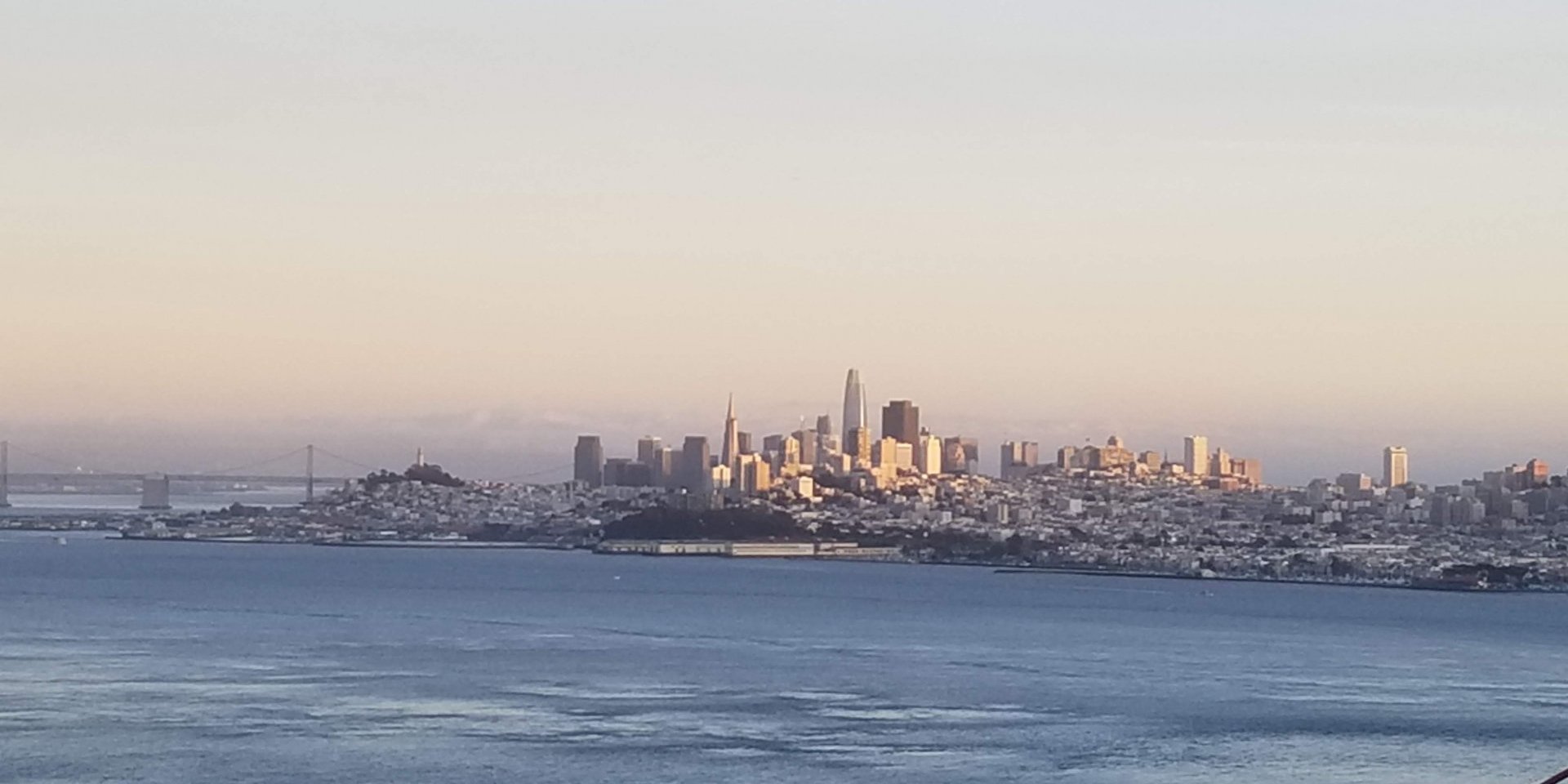
San Francisco seen from Golden Gate Bridge.
San Francisco
It may be that summers are cool (or even cold) and windy in San Francisco, but winters are sunny and pleasant, many places the air pervaded by the refreshing fragrance of eucalyptus trees. Coldest month is January when the average low temperature is 7.8°C and the average high is 13.9°C.
In September, the warmest month, the average low temperature is 12.8°C and the average high is 21.1°C. Always dress in layers when going out: a t-shirt, a light sweater plus a jacket; remove as needed.
San Francisco is close to anything you may want: bustling tourist city, second largest Chinatown outside of Asia, wineries, ocean and big waves, mountains, hiking trails and national parks.
Due to its small size (11 km long by 11 km wide.), it makes it easy to see a lot in just one day, but be prepared to climb some of the more than 50 hills the city is built on. If walking is not your cup of tea, you may want to use the "hop on hop off" tour buses.
These buses give you the chance to ride around the city and stop at many top attractions and if bought on street will cost between $55 (classic ticket for one day) and $79 (for two day deluxe ticket that includes night tour), per adult.
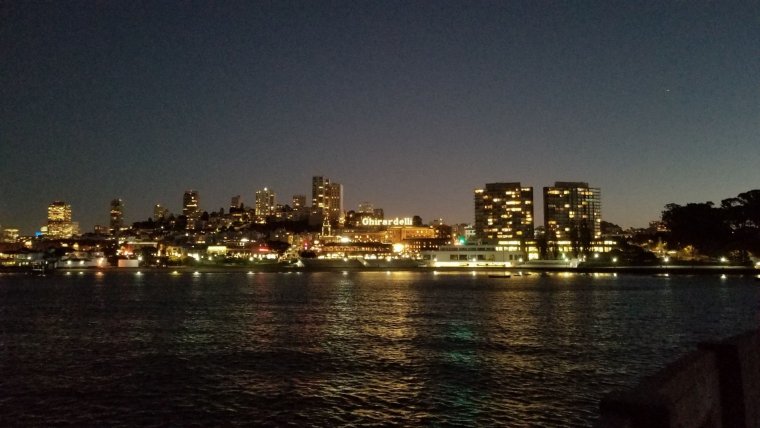
Marina District.
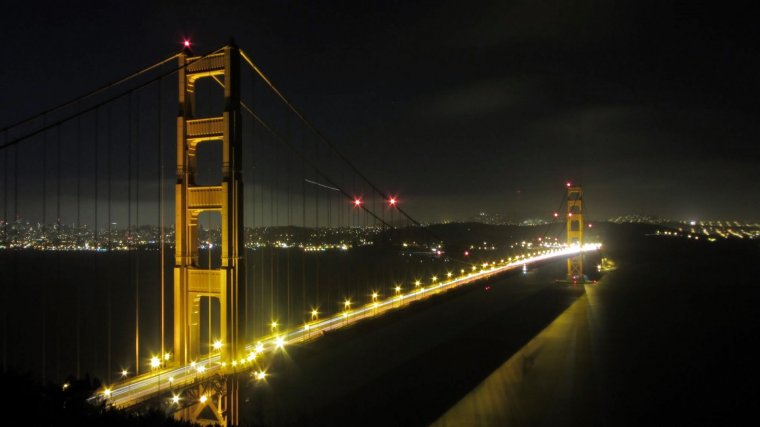
Golden Gate Bridge from Battery Spencer.
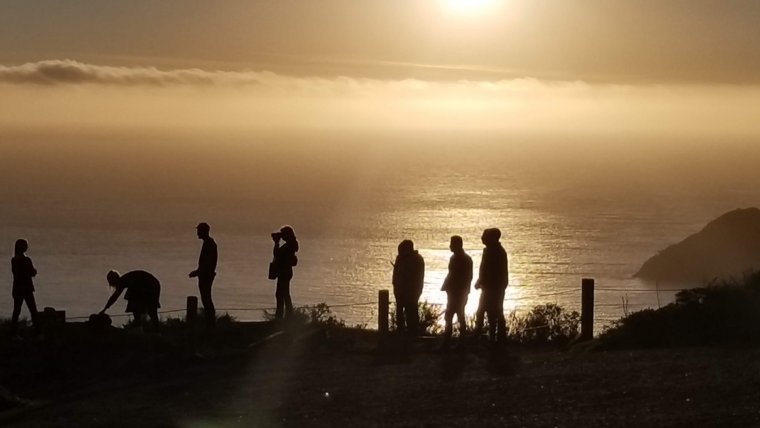
Tourists at Battery Spencer overlook on the North side of the bridge. During the early 1900’s, Battery Spencer was one of the main protection points for the San Francisco harbor. It featured multiple 12” guns.
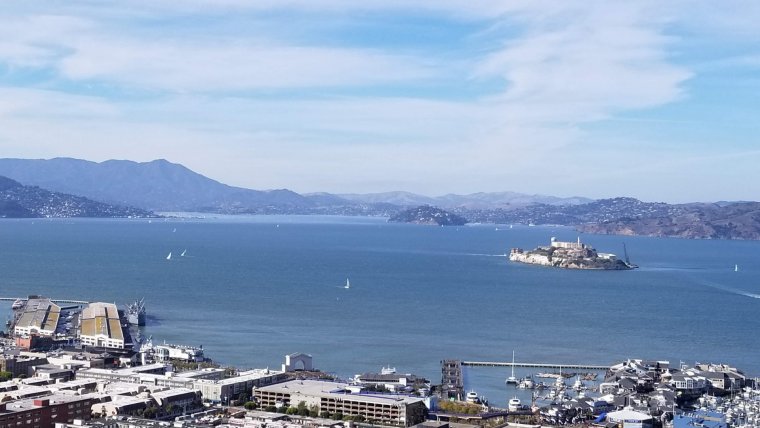
Alcatraz island seen from top of Coit Tower (64 m) located in the Telegraph Hill neighborhood. The tower was built between 1932 and 1933 and was dedicated to the volunteer firemen who had died in San Francisco's five major fires.
Pigeon Point Lighthouse
On Route 1, 50 miles south of San Francisco, is the 115-foot Pigeon Point Lighthouse. It is the tallest lighthouse (tied with Point Arena Light) on the West Coast of the United States. Its five-wick lard oil (pig fat) lamp, and first-order Fresnel lens, comprised of 1,008 prisms, was first lit at sunset, November 15, 1872.
The lens stands 16 feet tall, 6 feet in diameter, and weighs 2,000 pounds. Now on display in the Fog Signal building, it sat in a lantern room constructed at the Lighthouse Service's general depot in New York before being shipped around the Horn.
Although the original Fresnel lens is no longer in use, the lighthouse is still an active U.S. Coast Guard aid to navigation using a Vega Marine Rotating Beacon.
The lighthouse and the land around have been preserved as Pigeon Point Light Station State Historic Park, a California state park. The lighthouse is also listed on the National Register of Historic Places, and designated as a California Historical Landmark. Currently the lighthouse is closed until the structure can be restored. The lighthouse may still be viewed from the grounds.
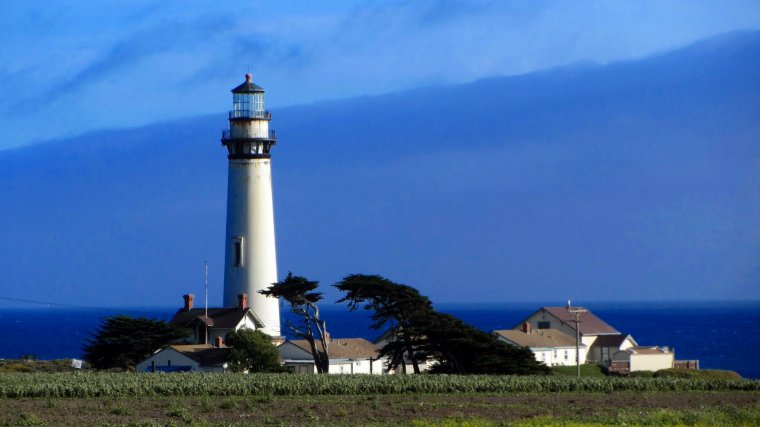
Pigeon Point Lighthouse
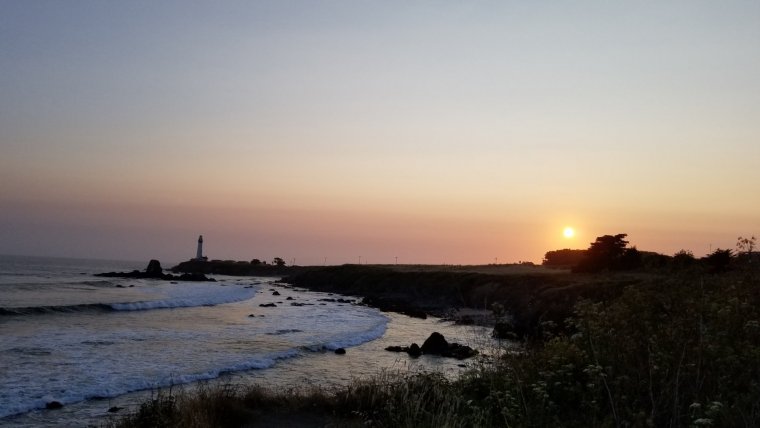
Pigeon Point Lighthouse
Carmel by the Sea
Located on a hill overlooking the rugged Pacific coastline, with old pine and cypress trees, Carmel by the Sea is a one hundred years old small town just south of Pebble Beach and Monterey. A prime real estate location, the town has some interesting peculiarities:
• No street addresses. Early residents opted to use names for their homes and considered to be bad luck to do otherwise.
• No street lights. Which is great as the lack of light pollution enables you to enjoy the night sky. But the large number of big trees make the pavement uneven, so make sure you carry a flashlight. Which brings us to the next quirk that was cast into a city ordinance:
• No high heels allowed. The municipal code of Carmel bans wearing shoes having heels more than 2 inches in height or with a base of less than one square inch unless the wearer has obtained a permit for them. This law was authored by the city attorney in 1963 to defend the city from lawsuits resulting from wearers of high-heeled shoes tripping over irregular pavement distorted by tree roots. Permits are available without charge at City Hall.
• No chain restaurants. There are over forty eight restaurants in Carmel, but if you are a fan of McDonald's or other fast food chain restaurant, you will probably need to go to nearby Monterey.
Where to Stay
There are over 30 hotels and inns available in Carmel, besides private home rentals. Prices are anywhere between $36 for a 2-star inn per night to $940 at nearby 5-star The Lodge at Pebble Beach.
What to do in Carmel
• Besides getting mesmerized by the big ocean waves or the architecture of the multimillion dollar homes lining up Scenic Road, you can visit The San Carlos Borroméo del Rio Carmelo Mission Museum.
Known simply as the Carmel Mission, was founded in 1771 by franciscan priest Junipero Serra and was once the headquarters for the entire California mission system. There you can see Father Serra's austere room: a small table and chair and a narrow wooden bed. His book collection, was identified as “California's first library.”
• There are about 20 wine tasting rooms in Carmel-by-the-Sea and just about every popular varietal is available: Chardonnay, Pinot Noir and Cabernet Sauvignon are the most common. But others include Sauvignon Blanc, Merlot, Zinfandel and less common types such as Grenache, Mourvedre, Barbera and Falanghina.
• There are 100 art galleries within the one-square-mile of downtown Carmel. Sunset Center's Marjorie Evans Gallery hosts exhibitions of local artists' work, as does the Center for Photographic Art.
• Sunset Center, Pacific Repertory Theatre and Forest Theater Guild will entertain with music and live theater.
• Electric bike tours along the rugged coastline and through cypress groves, stopping at viewpoints: Lone Cypress, Point Pinos Lighthouse, Lover's Point, Asilomar Beach, 17-Mile Drive. Tour duration is three hours, includes food and drinks. Cost $59 per person.
• Marine Scientist guided exploration of marine flora and fauna around beaches of Point Pinos. $35 per person.
• Daytime Catamaran Sailing Cruise. An eco-friendly way to see Monterey Bay and a piece of the Pacific Ocean. Trip lasts about one hour and costs $65 per person. If you get motion sickness, ensure getting adequate medication before starting the trip.
• Sail to get the chance to encounter wildlife on Monterey Bay like seals, otters, whales, dolphins, turtles, sharks. Group size is up to six persons and costs $165 per person.
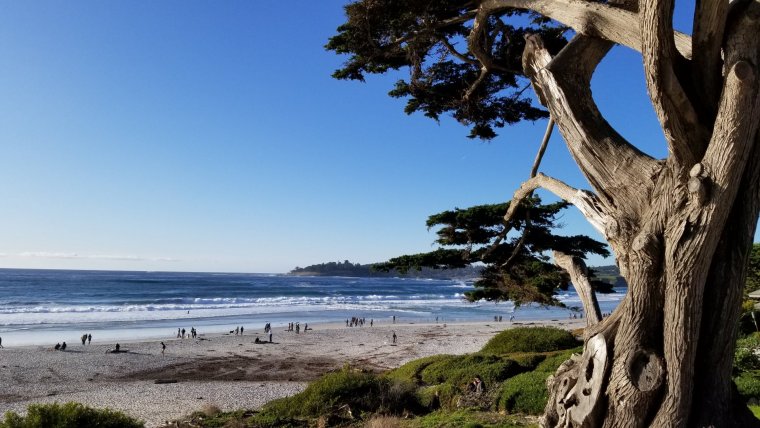
Carmel Beach view to Monterey Peninsula.
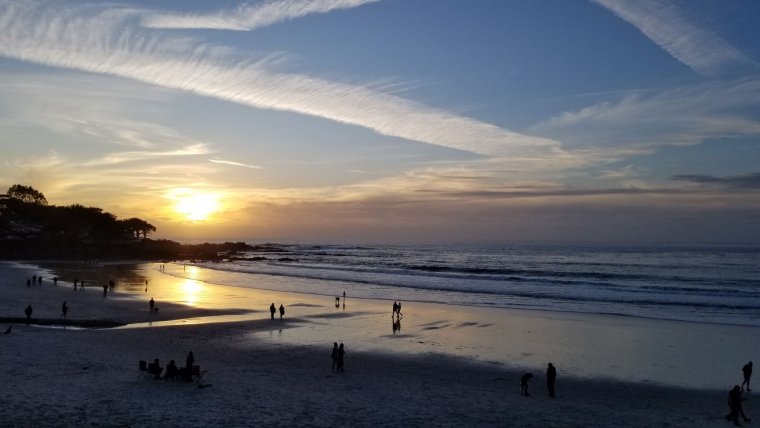
Sunset over Point Lobos.
Scenic Seventeen Mile Drive
Located between Monterey, Pacific Grove, Carmel and the Pacific Ocean is the Pebble Beach resort. It was established in 1880 through the land acquisition by the Pacific Improvement Company, a consortium of railroad barons, and the opening of Hotel Del Monte.
By 1892, the owners laid out a scenic road that was called the 17-Mile Drive, meandering along the beaches and among the forested areas between Monterey and Carmel. The drive was offered as a pleasure excursion to guests of Hotel Del Monte, and it was intended to attract wealthy buyers of large and scenic residential plots.
In 1919 Pebble Beach Golf Links and The Lodge open to the public. In 1972 the first US Open Championship is held at Pebble Beach and again in 1982, 1992, 2000, 2010 and 2019.
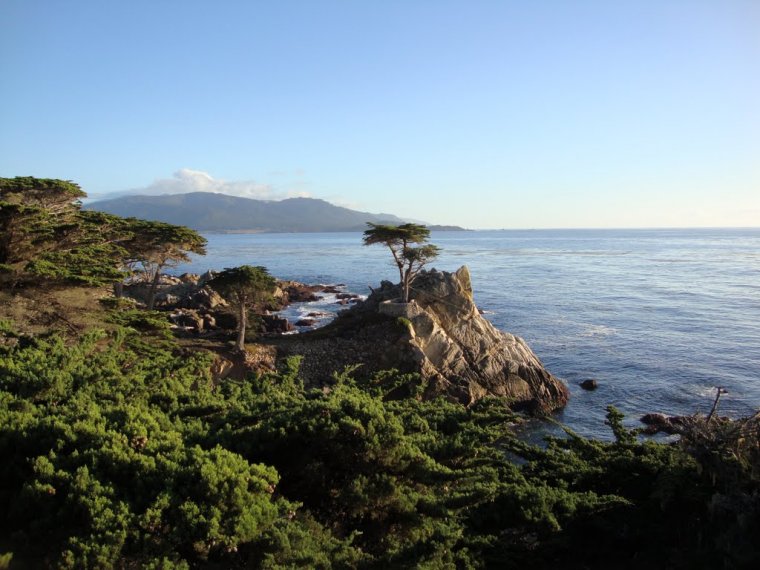
The Lone Cypress, one of the most photographed trees in the world is 250 years old and on life support (fences and cables prevent it from collapsing).
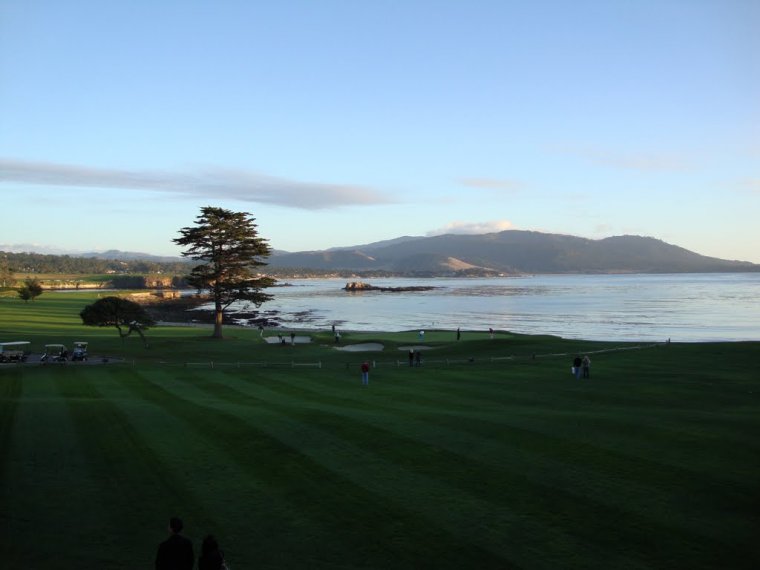
Pebble Beach Golf Links.
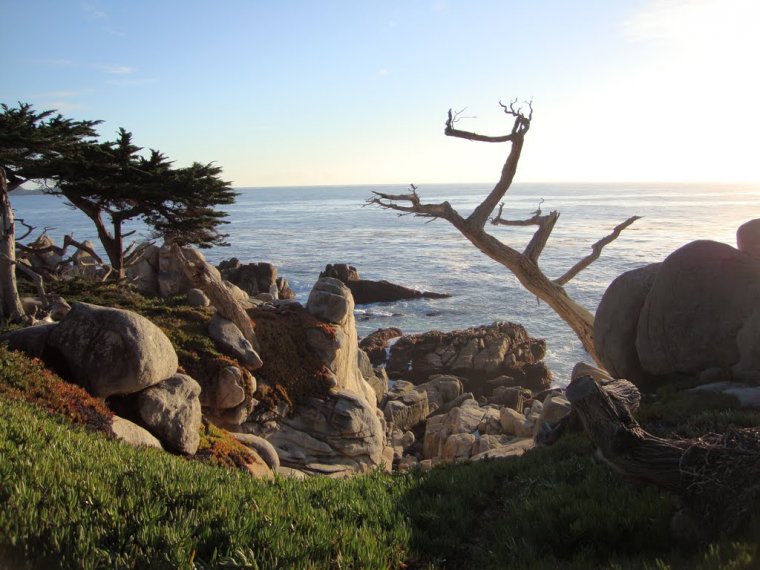
Ghost Trees at Pescadero Point.
YOU MAY ALSO LIKE





